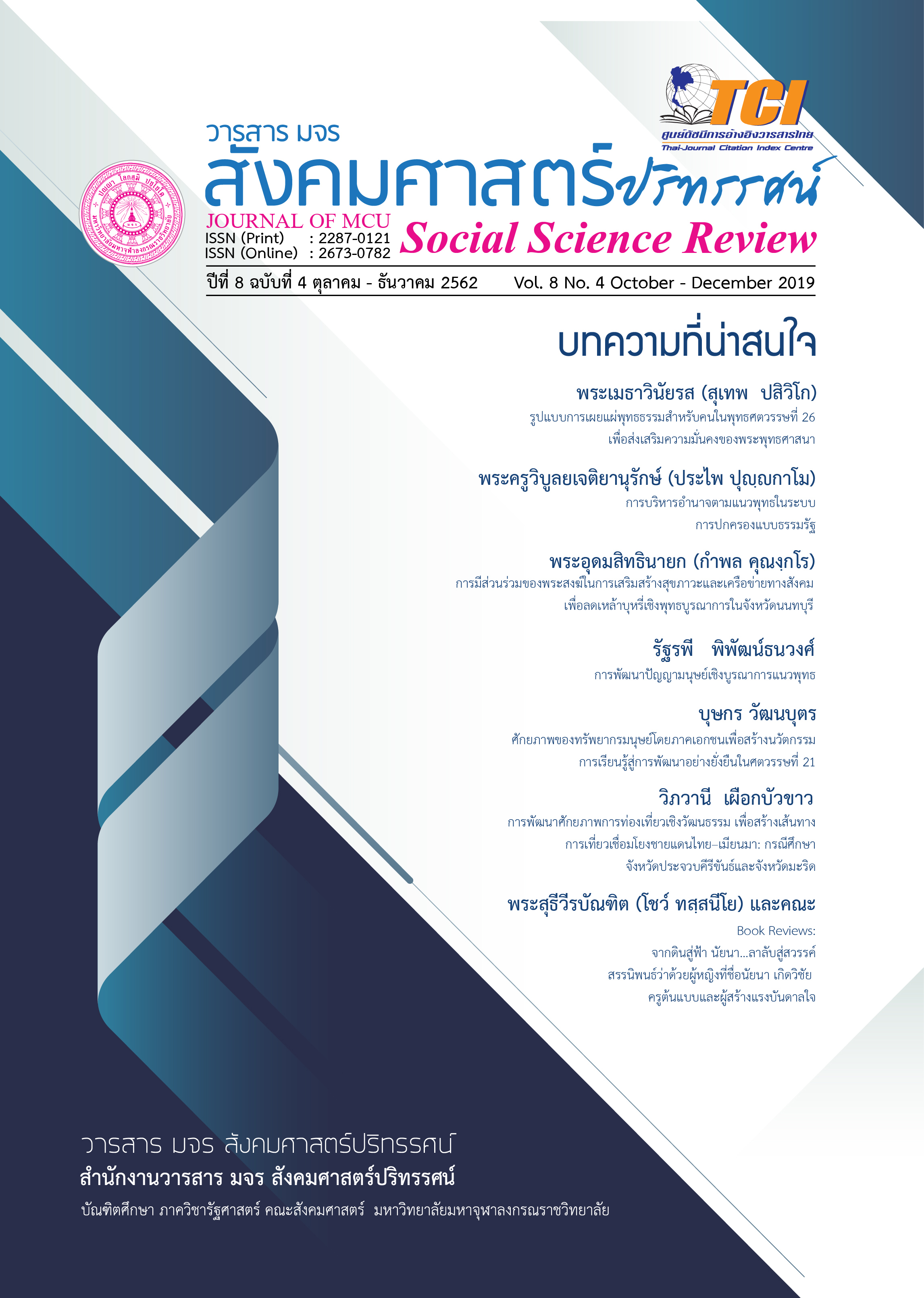ธรรมวิชัย: ระบบการบริหารการปกครองของพระเจ้าอโศกมหาราช
คำสำคัญ:
ธรรมวิชัย, ระบบการบริหาร, การปกครอง, พระเจ้าอโศกมหาราชบทคัดย่อ
บทความนี้มีวัตถุประสงค์ เพื่อศึกษาระบบการบริหารการปกครองของพระเจ้าอโศกมหาราช ที่ทรงยึดมั่นในหลักแห่งธรรมวิชัย คือ การชนะทางด้านจิตใจ เป็นชัยชนะอันสูงสุด เป็นชัยชนะแห่งธรรมซึ่งเป็นต้นแบบของการเมืองใหม่ที่ใช้ธรรมนำหน้าอย่างแท้จริง ที่สามารถเข้าถึงวิถีแห่งสันติ อหิงสา ขันติธรรม และความสงบสุข โดยที่พระองค์ทรงบริหารราชการแผ่นดินภายใต้นโยบายธรรมวิชัย ซึ่งเป็นระบอบประชาธิปไตยเต็มที่แต่เอนไปทางด้านปิตาธิปไตย คือ ทรงปกครองอาณาประชาราษฎร์ประดุจ พ่อปกครองลูก หรือทรงปกครองแผ่นดินโดยธรรม ส่งเสริมกิจการสาธารณูปการ สวัสดิการสังคม ทำนุบำรุงศิลปะและวัฒนธรรม การจัดบริการสาธารณประโยชน์ และสังคมสงเคราะห์ สร้างศิลาจารึกสื่อสารเสริมธรรม ประกาศหลักการแห่งเสรีภาพ แถลงเรื่องที่เป็นนโยบายของรัฐในทางธรรม ที่จะให้ผู้บริหารปกครองท้องถิ่นนำไปสั่งสอนประชาชน แต่งตั้งธรรมมหาอำมาตย์ เป็นทูตแห่งธรรมในการเผยแผ่ พระธรรม โดยพระองค์ก็เสด็จธรรมยาตราไปยังพุทธสถานทุกแห่ง เพื่อศึกษาและปฏิบัติธรรม
พระเจ้าอโศกมหาราชทรงทำสงครามทำลายล้างอย่างยืดเยื้อกับแคว้นกาลิงคะ ปัจจุบันคือรัฐ โอริสสา ทรงเอาชนะแคว้นกาลิงคะ ซึ่งเป็นแคว้นสุดท้ายที่พระองค์ทรงพิชิตได้ เป็นสงครามครั้งยิ่งใหญ่ที่สุด แต่ชัยชนะนั้นกลับสร้างความสลดสังเวชพระทัยแก่พระองค์ ซึ่งทำให้พระองค์ได้รับสมัญญานามว่า จัณฑาโศกราช คือ พระเจ้าอโศกผู้โหดเหี้ยม แต่หลังจากที่พระองค์หันมานับถือวิถีแห่งสันติและเมตตาตามหลักพระพุทธศาสนา จึงทรงประกาศละเลิกสังคามวิชัยหันมาดำเนินนโยบายเดชานุภาพแบบ “ธรรมวิชัย” ด้วยรัฐประศาสโนบายนี้เอง จึงทำให้พระองค์ทรงเป็นต้นแบบของการเมืองใหม่ที่ใช้ธรรมนำหน้า หรือจะกล่าวอีกนัยหนึ่งว่า พระเจ้าอโศกมหาราชได้นำโลกไปสู่ความเมตตา กรุณา อหิงสาและสันติภาพด้วยวิถีทางแห่งความสงบสุข
เอกสารอ้างอิง
Karuna-Ruangurai Kutsalasai. (2006). Asokmaharatlækhokhiankhonlaruangdiaokan (Ashoka the Great and Eassays). 3rd edition, Bangkok: Siam Publishing.
Chamnong Thongprasert. (1996). Buddhism, Social and Politics. 2nd edition, Bangkok: Compactprint Limited Printing.
_________. Applied Philosophy-India. (1996). 2nd edition, Bangkok: H N Group Limited Printing.
Prayong Suwanbuppha. (2001). Philosophy of State Eastern-Western Concepts. Bangkok: Sopha Printing.
Assoc.Prof.Dr.Chēt tingsanchali. (2013). The Greatest Places of Reminding of Lord Bhudda in India-Nepal. Nonthaburi: Museum Press Printing.
Phraphō̜nmakunapon. (2011). Make a Pilgrimage. 36rd edition, Bangkok: Phrabhuddasasana Press by Dhammasapha.
________. (2009). Ashoka Stone Tablets (Wheel of Dhamma on the Four Lion Heads) Public Administration of Meritocracy. 1st edition, Samutprakan: Palidham Publishing.
________. (2012). Kalanukrom the Bhuddism in the World from the Past until Now. 1st edition, Bangkok: Palidham Publishinng.
Panorama Worldwide Limited. (2006). Follow the Way of Lord Buddha. 1st edition, Bangkok: Praew Publishing.
Assoc.Prof.Dr. Chēt tingsanchali. (2015). The History of Indian and Southeastern Asian Arts. Nonthaburi: Museum Press Publishing.
Siriwan Khumho. (2004). 7 Maharat King of Great. Bangkok: The Books Publishing.
Sulak Siwarak (S. Siwarak). (1991). To Understand Ashoka the Great and Ashokawadhana. 2nd edition, Bangkok: Kledthai Company Limited.
Udom Choēikīwong. (2006). Ramkhamhaeng the Great. Bangkok: Phumipanya Press.
Phramahāwutchai Wachirametee (W. Wachirametee). (4thApril, 2018). Ashoka the Great, who Created the New Politics idea. [online]. Source: http://www.vimuttayalaya.net/DharmaDaily.aspx?id=73&page=10
ดาวน์โหลด
เผยแพร่แล้ว
รูปแบบการอ้างอิง
ฉบับ
ประเภทบทความ
สัญญาอนุญาต
ลิขสิทธิ์ (c) 2019 วารสาร มจร สังคมศาสตร์ปริทรรศน์

อนุญาตภายใต้เงื่อนไข Creative Commons Attribution-NonCommercial-NoDerivatives 4.0 International License.
เพื่อให้เป็นไปตามกฎหมายลิขสิทธิ์ ผู้นิพนธ์ทุกท่านต้องลงลายมือชื่อในแบบฟอร์มใบมอบลิขสิทธิ์บทความให้แก่วารสารฯ พร้อมกับบทความต้นฉบับที่ได้แก้ไขครั้งสุดท้าย นอกจากนี้ ผู้นิพนธ์ทุกท่านต้องยืนยันว่าบทความต้นฉบับที่ส่งมาตีพิมพ์นั้น ได้ส่งมาตีพิมพ์เฉพาะในวารสาร มจร สังคมศาสตร์ปริทรรศน์ เพียงแห่งเดียวเท่านั้น หากมีการใช้ภาพหรือตารางหรือเนื้อหาอื่นๆ ของผู้นิพนธ์อื่นที่ปรากฏในสิ่งตีพิมพ์อื่นมาแล้ว ผู้นิพนธ์ต้องขออนุญาตเจ้าของลิขสิทธิ์ก่อน พร้อมทั้งแสดงหนังสือที่ได้รับการยินยอมต่อบรรณาธิการ ก่อนที่บทความจะได้รับการตีพิมพ์ หากไม่เป็นไปตามข้อกำหนดเบื้องต้น ทางวารสารจะถอดบทความของท่านออกโดยไม่มีข้อยกเว้นใดๆ ทั้งสิ้น





